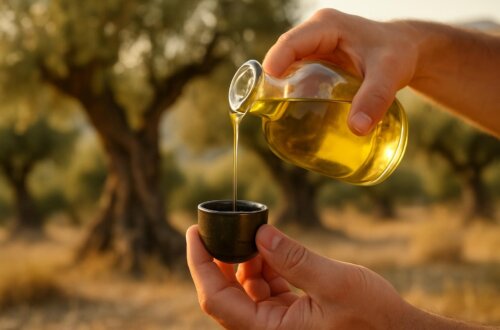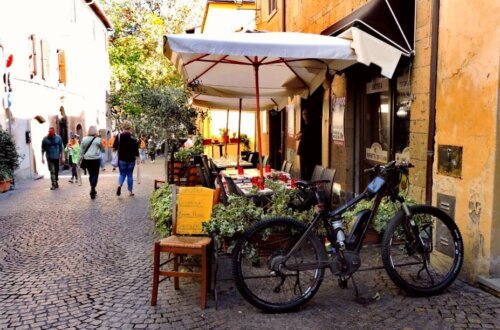
Olive Oil Tasting in Puglia: Discover Italy’s Finest Extra Virgin Oils
The Soul of Southern Italy in a Drop of Gold
Picture this: you’re standing in an ancient olive grove under the warm Mediterranean sun, surrounded by gnarled trees that have witnessed centuries of history. In your hand is a small glass containing liquid gold—Puglia’s celebrated extra virgin olive oil. As you bring it to your lips, you’re not just tasting oil; you’re experiencing the very essence of Southern Italy.
Puglia, the heel of Italy’s boot, produces over 40% of the country’s olive oil, making it the undisputed olive oil capital of the nation. But this isn’t just about statistics or production volumes. Olive oil tasting in Puglia is a cultural immersion—a journey that connects you with ancient traditions, passionate artisans, and a landscape shaped by 60 million olive trees, some standing for more than 2,000 years.
Whether you’re a food enthusiast, a curious traveler, or someone who simply wants to understand what makes truly exceptional olive oil, this guide will take you through everything you need to know about olive oil tasting in Puglia. You’ll discover how to taste like an expert, where to find the most authentic experiences, and why this region’s liquid gold deserves a place in your culinary adventures.
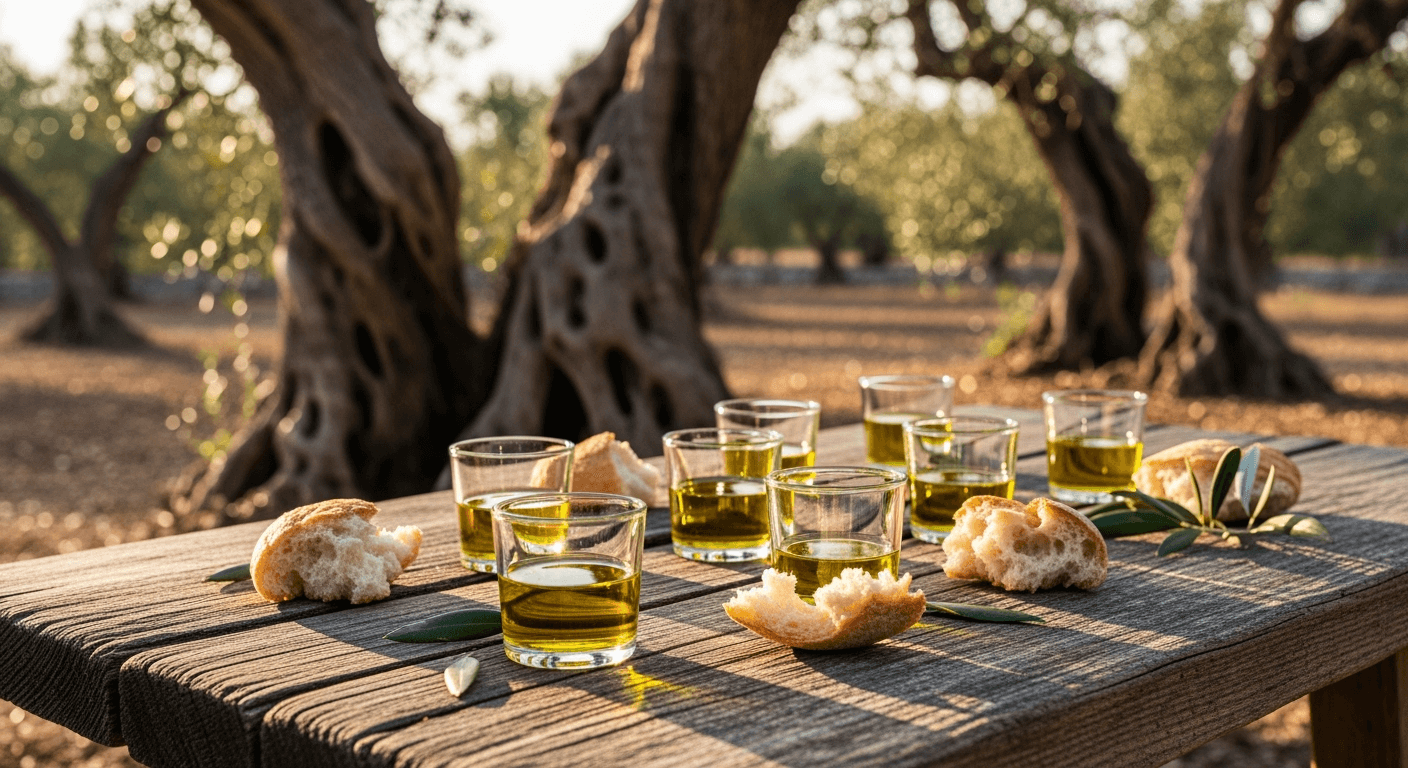
Why Puglia Is the Heart of Olive Oil Production
The Region That Fuels Italy’s Olive Oil Legacy
Puglia’s dominance in olive oil production isn’t accidental—it’s the result of perfect natural conditions meeting centuries of agricultural expertise. The region stretches along Italy’s southeastern coast, blessed with limestone-rich soil that provides excellent drainage, abundant Mediterranean sunshine, and cooling breezes from the Adriatic Sea. These elements create an ideal environment for olive cultivation that few other places can match.
The numbers tell a compelling story: Puglia produces over 300,000 tons of olive oil annually from its 60 million olive trees. This massive production is spread across key areas, each with its own distinctive characteristics:
- Salento (the southern peninsula): Known for robust, peppery oils with intense flavor profiles
- Bari and Central Puglia: Produces balanced oils with fruity notes and moderate intensity
- Brindisi: Home to some of the oldest olive groves and traditional production methods
- Foggia Province: Offers more delicate oils with subtle, refined flavors
- Taranto: Combines coastal influences with inland terroir for unique taste profiles
But what truly sets Puglia apart are its ancient olive trees—living monuments that connect the present to the distant past. Some of these majestic trees, particularly in the Salento region, are estimated to be over 2,000 years old. Their twisted trunks and sprawling canopies have witnessed the rise and fall of empires, and they continue to produce olives that capture the essence of this timeless landscape.
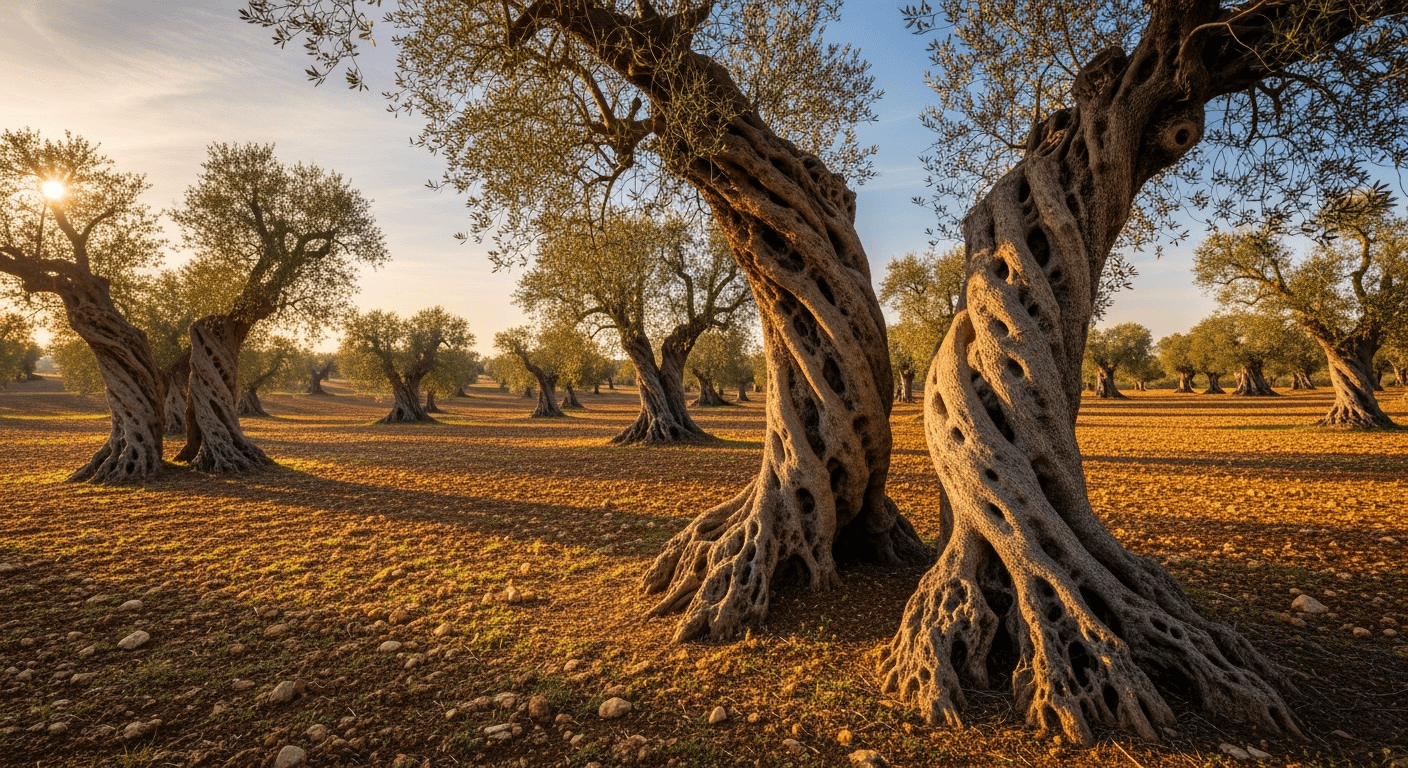
The Art of Olive Oil Tasting
How to Taste Like an Expert
Olive oil tasting is a refined sensory experience that engages sight, smell, and taste. Professional tasters follow a systematic approach, and you can too—even if you’re just beginning your olive oil journey.
The Visual Assessment
Start by observing the oil’s appearance. Pour a small amount into a clear glass (professionals use cobalt blue or dark glasses to avoid color bias). You’ll notice colors ranging from vibrant green to golden yellow. However, here’s an insider secret: color isn’t actually a reliable indicator of quality. A bright green oil isn’t necessarily better than a golden one—it simply reflects the olive variety, ripeness at harvest, and processing methods.
The Aromatic Experience
Cup the glass in your hands to warm the oil slightly, then cover it with your other hand and swirl gently. This releases the volatile aromatic compounds. Bring the glass to your nose and inhale deeply. What do you smell?
High-quality extra virgin olive oil should present fresh, complex aromas:
- Fruity notes: Fresh olives, apple, banana, or artichoke
- Herbaceous scents: Freshly cut grass, mint, or basil
- Vegetal aromas: Tomato leaf, green almond, or green tea
If you detect mustiness, rancidity, or a greasy smell, the oil is likely defective or past its prime.
The Tasting Technique
Now comes the most distinctive part of olive oil tasting—the “slurp” method. Take a small sip (about a teaspoon) and hold it in your mouth. Then, with your lips slightly parted, draw air in through your teeth while the oil is still on your tongue. This creates that distinctive slurping sound professionals make, but it serves a crucial purpose: aerating the oil spreads it across your palate and releases flavor compounds, allowing you to fully appreciate its complexity.
Notice three key sensations:
- Fruitiness: The pleasant olive flavor intensity
- Bitterness: A positive attribute indicating antioxidant-rich polyphenols
- Pungency: The peppery sensation in your throat (the famous “tickle” or “bite”)
These characteristics aren’t flaws—they’re signs of fresh, high-quality oil. A good Puglian oil might make you cough slightly from its peppery finish. Embrace it!
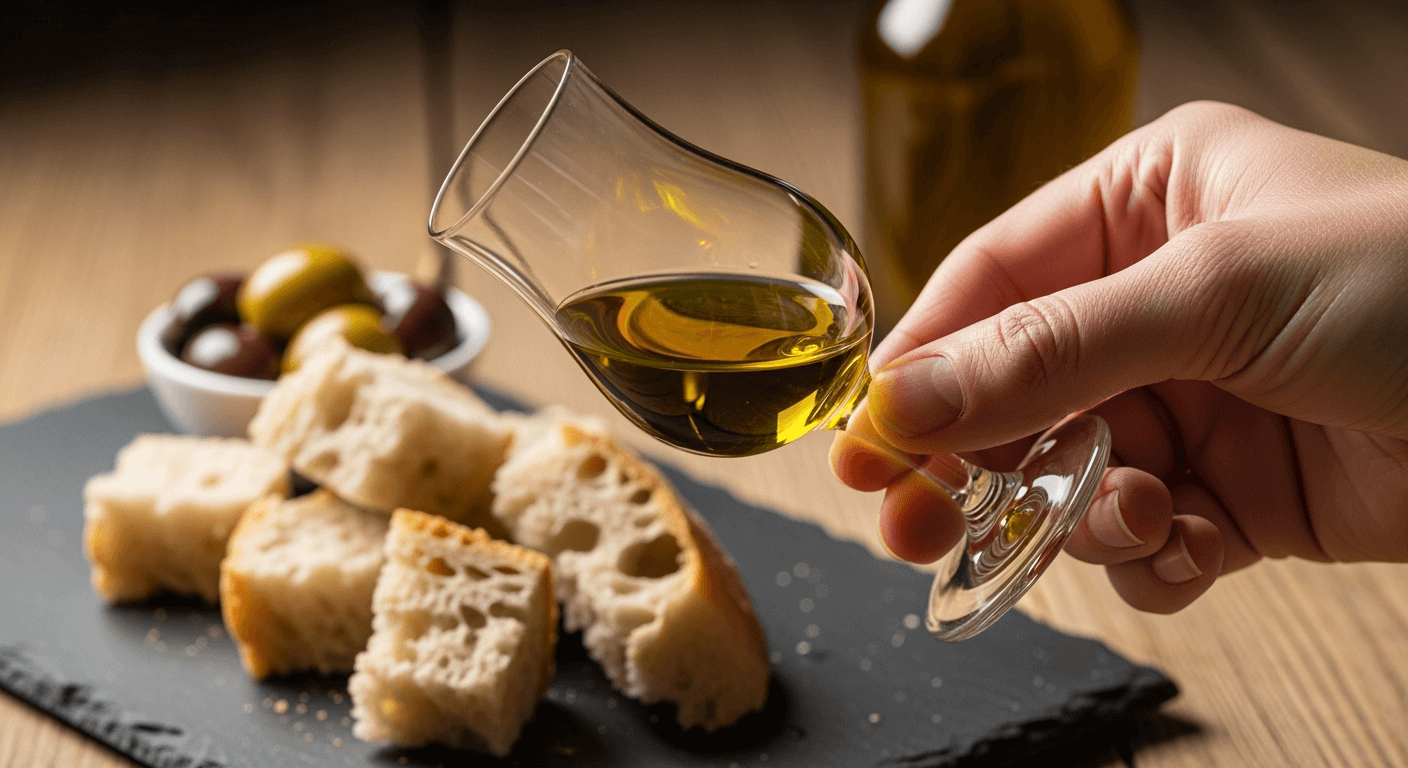
The Best Olive Oil Tasting Experiences in Puglia
Where to Go for Authentic Tastings
Puglia’s diverse geography means equally diverse tasting experiences. Here’s where to find the most memorable ones:
Salento: Bold and Unapologetic
The sun-drenched Salento peninsula produces some of Italy’s most characterful oils. The region’s Cellina di Nardò and Ogliarola Salentina varieties create oils with pronounced bitterness and a peppery kick that lingers beautifully.
Must-visit destinations:
- Masseria Brancati (near Ostuni): This historic estate offers comprehensive tours through centuries-old groves, followed by professional tastings that compare different harvest times and olive varieties
- Antica Masseria del Fano (Salve): A family-run operation where you’ll taste alongside the producers themselves, learning secrets passed through generations
Bari & Central Puglia: Tradition Meets Design
The central region balances tradition with innovation, producing oils that are both approachable and complex.
- Frantoio Muraglia: Perhaps Puglia’s most Instagram-famous producer, Muraglia combines exceptional oil with stunning hand-painted ceramic bottles. Their modern tasting rooms offer guided experiences that demystify olive oil quality, all while surrounded by beautiful design elements that make the experience memorable beyond the palate
Foggia Province: Subtle Sophistication
Northern Puglia’s gentler climate produces more delicate oils with nuanced flavors. Smaller, family-run estates here offer intimate experiences where you’ll often meet the farmers themselves, touring the groves before sitting down for tastings paired with local bread, cheeses, and vegetables.
Experiential Oleotourism
The rise of “oleotourism”—sustainable travel centered on olive oil culture—has created unique experiences that go beyond simple tastings:
- Combine your tasting with hands-on cooking classes using the estate’s oil
- Join harvest experiences in autumn, picking olives and following them through production
- Book vineyard-and-mill tours that pair olive oils with Puglian wines
- Stay overnight at working masserie (fortified farms) for full immersion in agricultural life
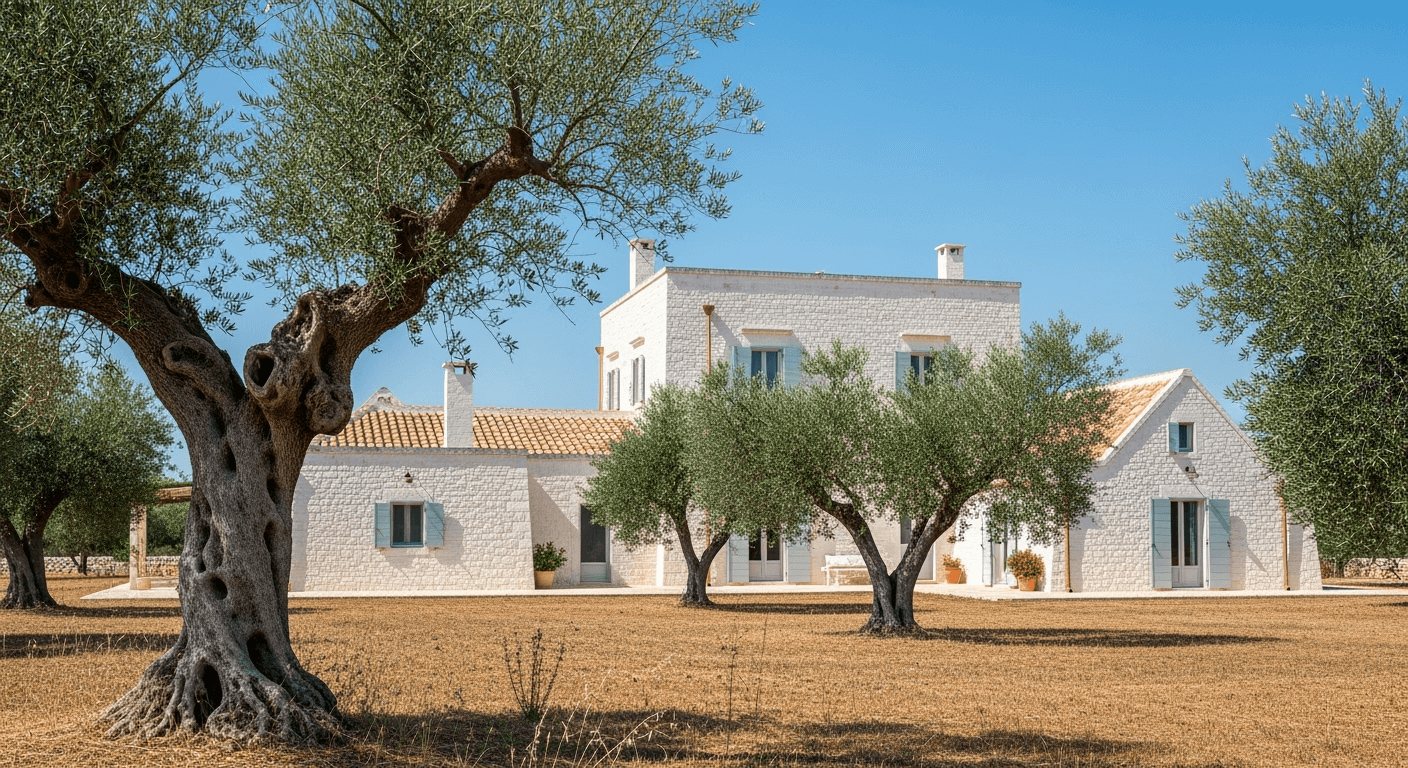
Understanding Olive Oil Quality and Labels
What “Extra Virgin” Really Means
Walking through an Italian supermarket or visiting a producer, you’ll encounter various olive oil categories. Understanding these distinctions helps you recognize true quality.
The Three Main Categories:
- Extra Virgin Olive Oil: The highest grade, extracted purely mechanically without heat or chemicals, with acidity below 0.8% and no taste defects. This is what you want.
- Virgin Olive Oil: Also mechanically extracted but with slightly higher acidity (up to 2%) and minor sensory defects. Rarely seen commercially.
- Refined Olive Oil: Industrially processed oil that has been chemically treated to remove defects. Often labeled simply as “olive oil” or “light olive oil”—avoid for tasting purposes.
Quality Markers to Look For:
When selecting oils in Puglia, these indicators signal exceptional quality:
- PDO (DOP) or PGI (IGP) Certifications: Protected Designation of Origin labels guarantee the oil comes from specific regions and meets strict standards. Look for:
- Terra di Bari DOP
- Colline di Brindisi DOP
- Dauno DOP
- Terre d’Otranto DOP
- Terre Tarentine DOP
- Harvest Date: Unlike wine, olive oil doesn’t improve with age. Fresh is best. Look for harvest dates within the past 12-18 months.
- Dark Glass Bottles: Quality producers use dark (green or brown) glass or tins to protect oil from light degradation. Clear bottles might look attractive but allow harmful UV exposure.
- Single-Estate or Single-Variety: Oils from a specific farm or olive cultivar typically offer more distinctive character than blends.
Compare oils from different PDOs during your visit—the terroir differences become immediately apparent, teaching you more about Puglia’s diversity than any guidebook could.

Visiting an Olive Mill (Frantoio) — From Tree to Bottle
Behind the Scenes of Puglian Olive Oil Production
Understanding how olive oil is made deepens your appreciation during tastings. Visiting a working frantoio (olive mill) reveals the craftsmanship behind every bottle.
The Production Process:
Harvesting (October-December)
The journey begins in the groves. Timing is crucial—harvesting too early yields less oil but more polyphenols and intense flavor; waiting too long increases yield but reduces quality. Traditional hand-picking is still practiced for the finest oils, though mechanical shakers are common for larger operations.
Immediate Processing
Quality begins with speed. The best producers process olives within 24 hours of harvesting, minimizing oxidation and fermentation that would compromise flavor. At the frantoio, you’ll see:
- Washing and defoliation: Removing leaves and cleaning the olives
- Crushing: Traditional stone mills or modern hammer crushers break down the olives into a paste
- Malaxation: Slowly mixing the paste for 20-40 minutes to help oil droplets combine
- Extraction: Modern centrifuges separate oil from water and solids
- Decanting and filtering: Final clarification before bottling
The term “cold-pressed” means processing occurs below 27°C (80°F), preserving delicate flavors and healthy compounds that heat would destroy.
When to Visit:
The harvest season (late October through December) offers the most exciting frantoio visits. The facilities buzz with activity, fresh oil flows, and the air fills with the intoxicating aroma of just-crushed olives. Many mills offer “new oil” tastings—ultra-fresh oil that’s cloudy, intensely green, and almost explosively flavorful.
If you can’t visit during harvest, spring offers beautiful countryside scenery when olive trees bloom with delicate white flowers, and most frantoi still operate for tours even if not actively producing.
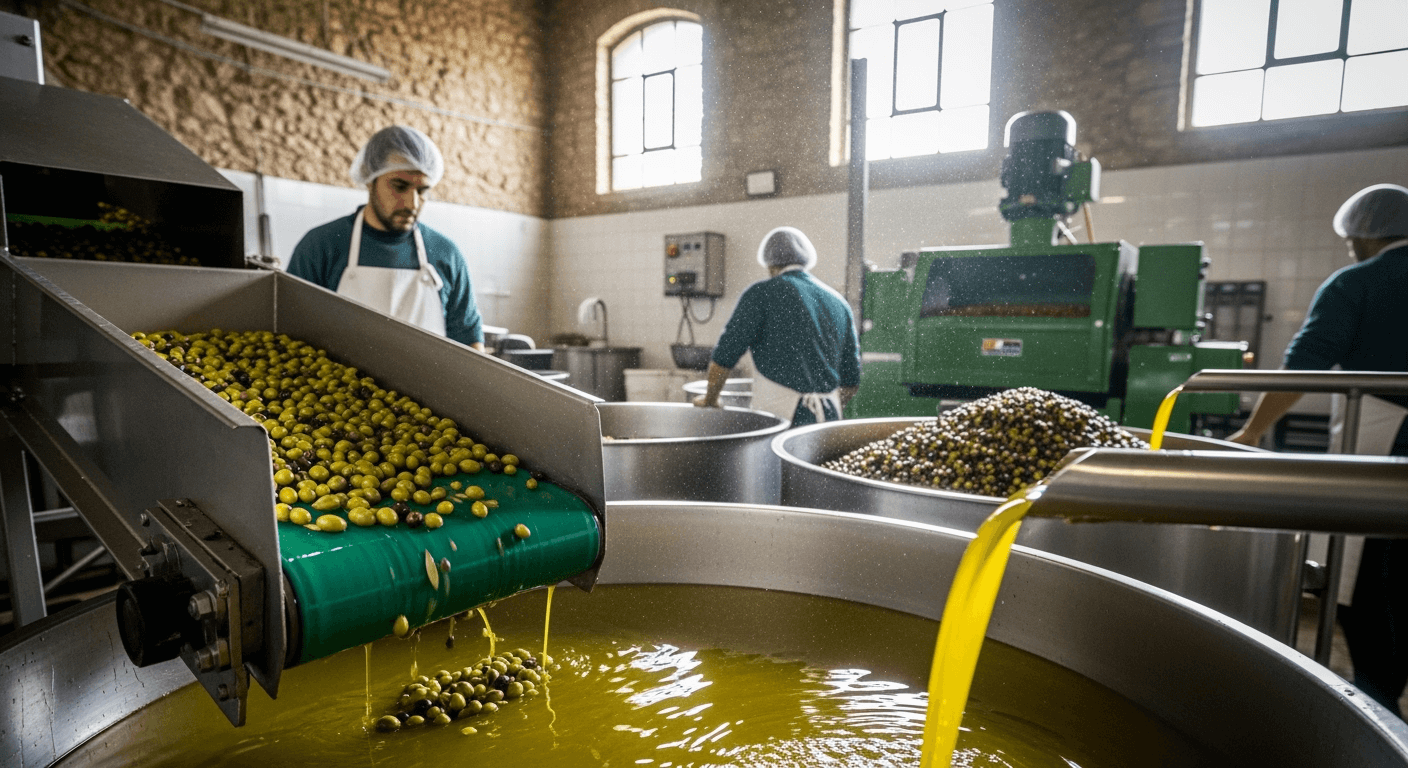
Pairing Olive Oil with Puglian Cuisine
Taste Puglia on Your Plate
Olive oil isn’t just a cooking ingredient in Puglia—it’s the foundation of the region’s celebrated cuisine. Understanding pairings elevates both the food and the oil.
Classic Puglian Dishes:
- Orecchiette con Cime di Rapa: Little ear-shaped pasta with turnip greens, garlic, and anchovies, finished with a generous drizzle of robust local oil
- Focaccia Barese: Puffy flatbread dimpled with fingerprints, topped with cherry tomatoes and liberally brushed with extra virgin olive oil
- Bruschetta Pugliese: Grilled bread rubbed with garlic and soaked in oil, sometimes topped with fresh tomatoes or burrata
- Fave e Cicoria: Fava bean puree with bitter chicory—the contrasting earthy and bitter flavors need a peppery oil to unite them
Pairing Principles:
Match intensity with intensity:
- Delicate oils (fruity, soft, minimal bitterness): Perfect for fish, delicate vegetables, mayonnaise, and desserts
- Medium oils (balanced fruitiness and bitterness): Ideal for salads, pasta, white meats, and legume soups
- Robust oils (intense, peppery, bitter): Stand up to grilled meats, hearty vegetables, aged cheeses, and bean dishes
Many tasting experiences include food pairings, allowing you to discover how the same oil can taste different depending on what accompanies it. A slice of rustic Puglian bread might emphasize an oil’s fruity notes, while bitter greens might highlight its peppery finish.
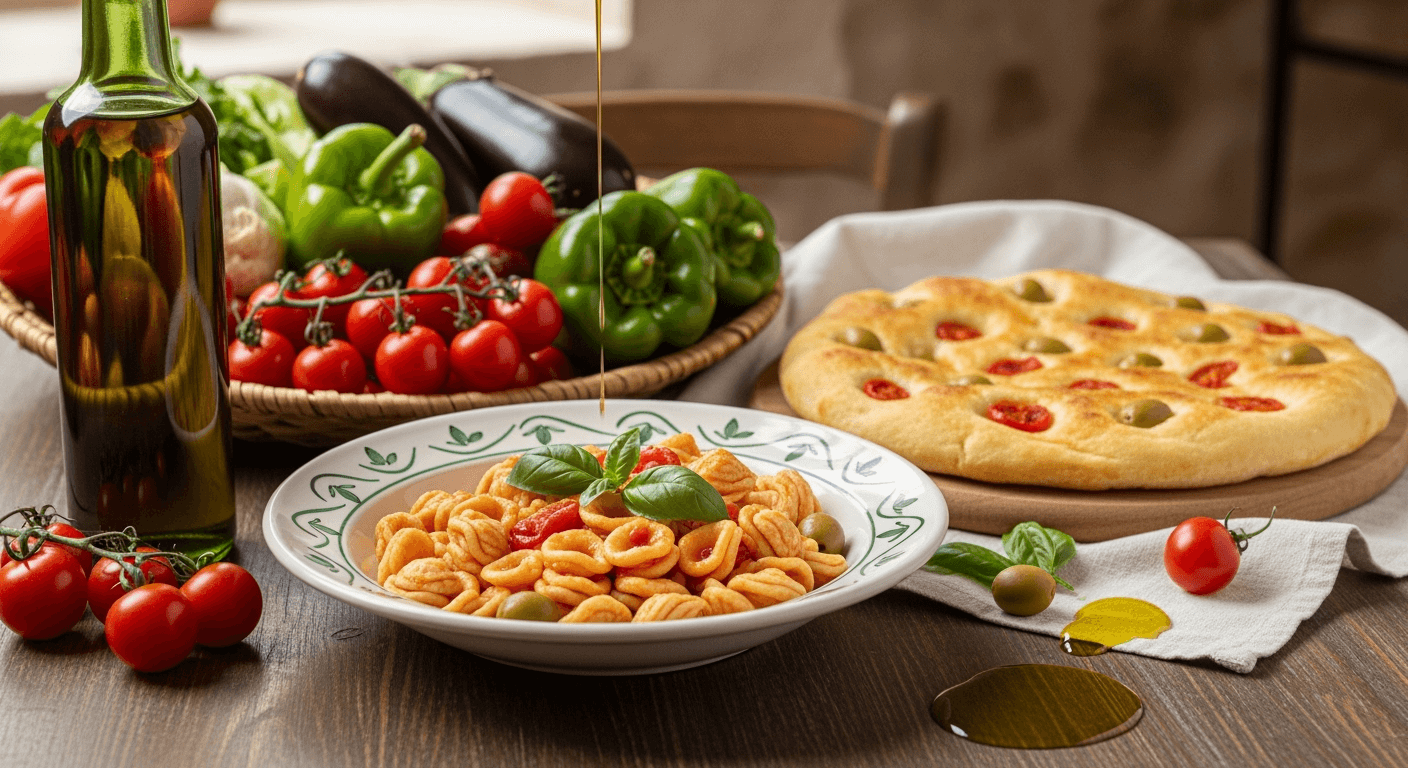
Sustainable and Organic Olive Oil in Puglia
Preserving the Land Through Tradition
Puglia’s olive oil industry faces both challenges and opportunities as it balances traditional practices with modern sustainability concerns.
The Xylella Crisis and Regeneration
In recent years, Puglia confronted a devastating outbreak of Xylella fastidiosa, a bacterial disease that killed millions of olive trees, particularly in Salento. This tragedy sparked renewed commitment to sustainable agriculture and replanting efforts. Many producers now focus on:
- Disease-resistant olive varieties
- Organic cultivation methods that strengthen tree immunity
- Biodiversity initiatives that create healthier ecosystems
Organic and Regenerative Practices
A growing number of Puglian producers have embraced organic certification and regenerative agriculture. These practices include:
- Eliminating synthetic pesticides and fertilizers
- Cover cropping to improve soil health
- Integrated pest management
- Water conservation techniques
- Maintaining ground cover and natural habitats for beneficial insects
Supporting Responsible Producers
When planning your olive oil tour, seek out estates committed to sustainability. These producers often offer more educational experiences, explaining not just how they make oil but how they steward the land for future generations. Your purchases and visits directly support farming practices that protect Puglia’s ancient agricultural heritage.
Planning Your Olive Oil Tasting Tour
Practical Tips for Visitors
Ready to experience Puglia’s liquid gold firsthand? Here’s how to plan an unforgettable olive oil adventure.
Best Times to Visit:
- October-December: Harvest season offers the most immersive experience, with active production and new oil tastings
- April-June: Spring brings comfortable temperatures, blooming olive trees, and beautiful countryside without summer crowds
- September: Early autumn combines pleasant weather with pre-harvest anticipation
Booking Your Experiences:
Search for “oleoturismo Puglia” or “degustazione olio d’oliva” to find organized tours. Many agriturismi (farm stays) and masserie offer tastings as part of their hospitality. Book in advance, especially during peak seasons, as small producers have limited capacity.
Getting There and Around:
- Airports: Bari (BRI) serves northern and central Puglia; Brindisi (BDS) is ideal for Salento
- Transportation: Renting a car is essential for visiting rural estates and exploring at your own pace. Many olive groves are remote and poorly served by public transport
- Duration: Allocate at least 3-4 days to meaningfully explore Puglia’s olive oil regions
Combining Attractions:
Enhance your olive oil tour by visiting Puglia’s other treasures:
- Alberobello: UNESCO World Heritage site famous for unique trulli houses
- Lecce: The “Florence of the South” with stunning Baroque architecture
- Ostuni: The dazzling “White City” perched on a hilltop
- Polignano a Mare: Dramatic coastal town built into limestone cliffs
- Matera: Just across the regional border, with ancient sassi cave dwellings
What to Bring Home:
Quality extra virgin olive oil makes an exceptional souvenir, but transport it carefully. Wrap bottles in clothing, pack in the center of checked luggage, or consider shipping from larger producers who offer this service. Remember that fresh olive oil is best consumed within a year, so don’t stockpile—buy what you’ll use.
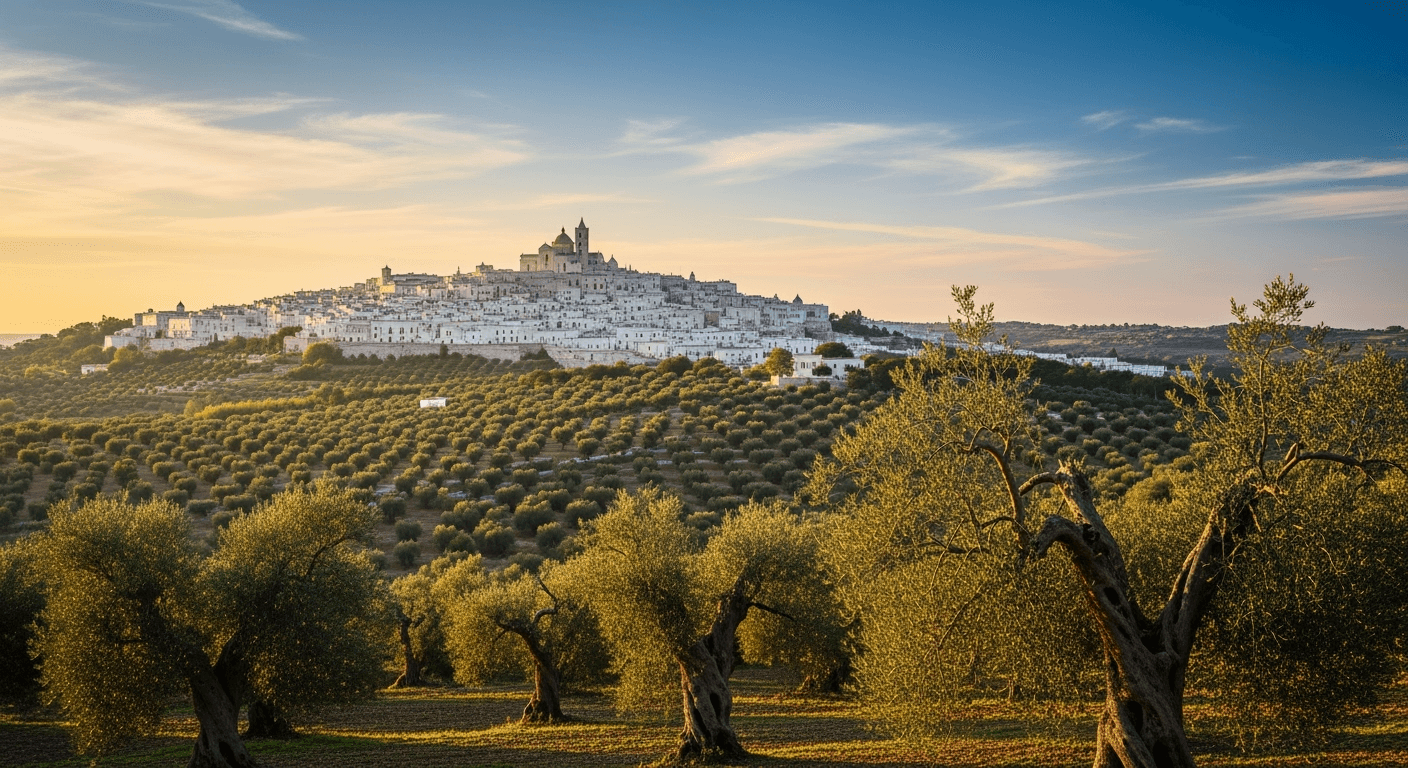
Bringing Puglia Home
Your olive oil tasting journey through Puglia offers more than gustatory pleasure—it’s a profound connection to land, tradition, and artisanal craftsmanship that has endured for millennia. When you return home with a bottle of carefully chosen extra virgin olive oil, you’re bringing back a tangible piece of Southern Italy’s soul.
Every time you drizzle that golden-green liquid over a simple salad, finish a pasta dish, or dip fresh bread, you’ll be transported back to sun-drenched groves, passionate producers, and the unmistakable peppery finish of oil that has captured the essence of its terroir.
The lessons you learn during your Puglian olive oil tastings—how to assess quality, understand production, and appreciate the nuances of different oils—will transform how you experience this fundamental ingredient forever. You’ll never settle for inferior oil again, and you’ll become an evangelist for quality, sharing your knowledge with friends and family.
Puglia’s olive oil culture represents something increasingly rare in our modern world: a direct connection between consumer and producer, between land and table, between ancient tradition and contemporary enjoyment. By participating in this tradition, even briefly as a visitor, you become part of a story that stretches back thousands of years and will, with continued support and appreciation, continue for thousands more.
So raise your tasting glass, embrace that peppery tickle, and toast to the liquid gold of Puglia—Italy’s finest contribution to the world’s table. Your journey awaits in the groves where history, flavor, and passion converge in every precious drop.

